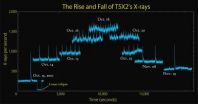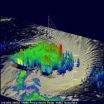(Press-News.org) An international team of physicists has determined a key parameter, which governs how neutrinos behave. This discovery measures a critical linchpin in the study of the tiny particles and in advancing the understanding of how these building blocks of all things, from galaxies to tea cups, came to be.
The Daya Bay Reactor Neutrino Experiment, a multinational collaboration including a team from Virginia Tech, discovered a new type of neutrino oscillation in which the particles appear to vanish as they travel. The researchers found that the rate of oscillations was much larger than many scientists had expected. This surprising result could open the gateway to a new understanding of fundamental physics and may eventually solve the riddle of why the universe today is dominated by matter as opposed to antimatter.
Neutrinos can be one of three types, which physicists call flavors. Owing to their bizarre physical – quantum mechanical – nature neutrinos can mix or oscillate between flavors. The rate of oscillation is controlled by parameters known as mixing angles.
The Daya Bay researchers gathered data that allowed them to measure the mixing angle theta one-three (θ13) with unmatched precision. Theta one-three, the last of three mixing angles to be measured, controls the rate at which electron neutrinos mix.
"This is the first time that any experiment has been able to definitively say that this mixing angle, theta one-three, is not zero," said Jonathan Link, associate professor of physics and director of Virginia Tech's Center for Neutrino Physics, home of the university's Daya Bay experiment team.
The Daya Bay collaboration's first results, which measured the mixing angle as part of the expression sin2 2 θ13, and found it to be equal to 0.092 plus or minus 0.017.
Neutrinos, the wispy particles that flooded the universe in the earliest moments after the big bang, are continually produced in the cores of stars and other nuclear reactions. Untouched by electromagnetism, they respond only to weak nuclear force and even weaker gravitational force, passing mostly unhindered through everything from planets to people. The challenge of capturing these elusive particles in the act of mixing inspired the Daya Bay collaboration in the design and precise placement of its detectors.
Traveling at close to the speed of light, the three basic neutrino "flavors" – electron, muon, and tau, as well as their corresponding antineutrinos − mix together in a process scientists refer to as oscillations but this process is extremely difficult to detect.
Collecting data from Dec. 24, 2011, until Feb. 17, 2012, scientists in the Daya Bay collaboration observed tens of thousands of interactions of electron antineutrinos in six massive detectors buried in the mountains adjacent to the powerful nuclear reactors of the Daya Bay Nuclear Power Plant in south China. These reactors produce millions of quadrillions of the elusive electron antineutrinos every second.
"Although we're still two detectors shy of the complete experimental design, we've had extraordinary success in determining the number of electron antineutrinos that disappear as they travel from the reactors to the detectors two kilometers away," said Kam-Biu Luk of the U.S. Department of Energy's Lawrence Berkeley National Laboratory and the University of California at Berkeley. Luk is co-spokesperson of the project and heads U.S. participation. "What we didn't expect was the sizable disappearance, equal to about 6 percent. Although vanishing has been observed in other reactor experiments over large distances, this is a new kind of disappearance for the reactor electron antineutrino."
The Daya Bay experiment counts the number of electron antineutrinos observed in detectors placed near to the reactors and calculates how many would reach the detectors placed further away if there were no oscillations. The number of antineutrinos that appear to vanish on the way due to their oscillation into other flavors determines the value of theta one-three.
"Even with only the six detectors already operating, we have more target mass than any similar experiment, plus as much or more reactor power," said William Edwards of Berkeley Lab and UC Berkeley is the U.S. project and operations manager for the Daya Bay experiment. Since Daya Bay will continue to have an interaction rate higher than any other experiment, Edwards said, "It is the leading theta one-three experiment in the world."
In the future, the initial results will be honed by collecting extensive additional data and reducing statistical and systematic errors.
"The large value of theta one-three opens up the opportunity for the scientific community to learn a great deal about the universe through neutrinos," said Deb Mohapatra, a Virginia Tech research scientist in the Center for Neutrino Physics.
The consortium researchers will be expanding the Daya Bay facilities for further experiments aimed at learning more about how neutrinos behave.
"The Daya Bay experiment plans to stop the current data-taking this summer to install a second detector in the Ling Ao Near Hall, and a fourth detector in the Far Hall, completing the experimental design," said Yifang Wang of China's Institute of High Energy Physics and co-spokesperson of the Daya Bay experiment.
Refined results will open the door to further investigations and influence the design of future neutrino experiments – including how to determine which neutrino flavors are the most massive, whether there is a difference between neutrino and antineutrino oscillations, and, eventually, why there is more matter than antimatter in the universe. Matter and antimatter presumably were created in equal amounts in the big bang and should have completely annihilated one another. So, the real question is, why there is any matter in the universe at all.
"Exemplary teamwork among the partners has led to this outstanding performance," said James Siegrist, associate director for high energy physics at the U.S. Department of Energy's Office of Science. "These notable first results are just the beginning for the world's foremost reactor neutrino experiment."
INFORMATION:
Virginia Tech Center for Neutrino Physics members who participated in the Daya Bay experiment besides Link and Mohapatra, are Leo Piilonen, incoming chair of the Department of Physics and The William E. Hassinger Jr. Senior Faculty Fellow in Physics; Patrick Huber, assistant professor of physics; Joseph Hor and Yue Meng, graduate students in the Department of Physics; and Jo Ellen Morgan, a physics laboratory specialist. The center's work was support by the U.S. Department of Energy and Virginia Tech.
The Daya Bay collaboration consists of scientists from the following countries and regions: China, the United States, Russia, the Czech Republic, Hong Kong, and Taiwan.
A copy of the paper and the participating institutions is available. Find information online, or contact Jonathan Link, Virginia Tech group leader at 540-231-5321 for further information.
The College of Science at Virginia Tech gives students a comprehensive foundation in the scientific method. Outstanding faculty members teach courses and conduct research in biological sciences, chemistry, economics, geosciences, mathematics, physics, psychology, and statistics. The college offers programs in cutting-edge areas including, among others, those in energy and the environment, developmental science across the lifespan, infectious diseases, computational science, nanoscience, and neuroscience. The College of Science is dedicated to fostering a research-intensive environment that promotes scientific inquiry and outreach.
A big discovery in the study of neutrinos, tiny particles that have a big role in the universe
2012-03-12
ELSE PRESS RELEASES FROM THIS DATE:
Wilshire Dental Care Now Offers Sedation Dentistry Options
2012-03-12
Dr. Afar, Los Angeles dentist at Wilshire Dental Care, is offering a variety of sedation dentistry techniques to make patient's experiences relaxing and pain-free. Sedation dentistry is the use of various techniques to reduce stress and pain during a dental procedure. Dr. Afar offers various types of sedation dentistry techniques to meet a variety of patient needs.
Oral sedation is the use of oral medications such as pills and liquids and is used when patients require only a small degree of sedation, and for procedures like dental crown preparation or fillings that do ...
New study shows that in US 'hot spots,' HIV infection among African-American women is 5-times higher than national estimate
2012-03-12
About ICAP
ICAP at Columbia University's Mailman School of Public Health is a global leader in public health, with a broad portfolio of research, training, health system strengthening, and service delivery programs in the United States and around the world. Founded in 2004, ICAP is committed to addressing critical health issues and to bettering lives by improving access to high-quality, equitable, and affordable health services. Working hand-in-hand with in-country partners, ICAP has supported more than 1,200 health facilities across 21 countries, including the US. More ...
Researchers reveal ways to make personalized cancer therapies more cost effective
2012-03-12
AURORA, Colo. -- As scientists continue making breakthroughs in personalized cancer treatment, delivering those therapies in the most cost effective manner has become increasingly important. Now researchers at the University of Colorado School of Medicine have identified new ways of doing just that, allowing more patients to benefit from this revolution in cancer care.
In a paper published in the British Journal of Cancer, health economist Adam Atherly, PhD, of the Colorado School of Public Health (CSPH) and medical oncologist D. Ross Camidge, MD, PhD, of the University ...
NASA's RXTE captures thermonuclear behavior of unique neutron star
2012-03-12
A neutron star is the closest thing to a black hole that astronomers can observe directly, crushing half a million times more mass than Earth into a sphere no larger than a city. In October 2010, a neutron star near the center of our galaxy erupted with hundreds of X-ray bursts that were powered by a barrage of thermonuclear explosions on the star's surface. NASA's Rossi X-ray Timing Explorer (RXTE) captured the month-long fusillade in extreme detail. Using this data, an international team of astronomers has been able to bridge a long-standing gap between theory and observation.
"In ...
NASA sees cyclone Irina weaker in Mozambique Channel
2012-03-12
Cyclone Irina has lived a long life and caused a lot of trouble, damages and death over the course of its life, and it appears to be finally fading over the Mozambique Channel.
On March 8 at 1500 UTC (10 a.m. EST), Irina's winds had finally dropped below 45 knots (51.7 mph/83.3 kph) to 35 knots (40.2 mph/64.8 kph) making it a minimal tropical storm. Irina was still in the southern Mozambique Channel, centered near 29.5 South and 37.8 East. That is about 350 miles southeast of Maputo, Mozambique. Irina is moving to the west at 8 knots (9.2 mph/14.8 kph).
The Moderate ...
NASA's TRMM satellite sees hot towers in Cyclone Koji
2012-03-12
Hot towers, or towering thunderclouds that give off an excessive amount of latent heat, usually indicate a tropical cyclone will strengthen in six hours, and NASA's TRMM satellite saw some of them as it passed by Tropical Storm Koji.
The Tropical Rainfall Measuring Mission (TRMM) satellite passed directly above an intensifying tropical storm in the South Indian Ocean called Koji on March 8, 2012 at 2053 UTC (3:53 p.m. EST). A rainfall analysis was made from TRMM Microwave Imager (TMI) and Precipitation Radar (PR) data. Those TRMM data reveal that Koji was getting organized ...
Protecting Our Clients - Michael T. Norris, Ltd. and John W. Callahan, Ltd., Illinois Criminal Defense Law Firm
2012-03-12
At the law offices of Michael T. Norris, Ltd. and John W. Callahan, Ltd., we know how to fight for the rights of the accused. After his arrest by the Hanover Park Police Department, our client was facing a difficult situation. The officers who stopped him claimed they could smell a strong odor of alcohol coming from his breath. They noted that his eyes were watery, glassy and bloodshot. Our client admitted to police that he had consumed alcohol at a local bar over the course of the evening. He later took a breath test which yielded a blood alcohol content of 0.17.
Upon ...
Mount Sinai researchers identify promising new drug target for kidney disease
2012-03-12
Researchers from Mount Sinai School of Medicine have identified a regulator protein that plays a crucial role in kidney fibrosis, a condition that leads to kidney failure. Finding this regulator provides a new therapeutic target for the millions of Americans affected by kidney failure. The research is published in the March 11 issue of Nature Medicine.
Led by John Cijiang He, MD, PhD, Professor of Nephrology and Pharmacology and Systems Therapeutics; and Avi Ma'ayan, PhD, Assistant Professor of Pharmacology and Systems Therapeutics at Mount Sinai School of Medicine, the ...
Experts: Integrate global water, food and energy policies to divert future conflict
2012-03-12
MARSEILLES, FRANCE -- As food and energy production intensify around the world, their demands on dwindling water resources have prompted the search for an innovative and collaborative solution. On Friday, March 16, a High Level Panel convened by the EDF Group and the CGIAR Challenge Program on Water and Food (CPWF) will gather in Marseilles at the Sixth World Water Forum (WWF6) to share experiences and results.
The panel will discuss how to embrace a "nexus" approach to water management, in which projects that tap water resources are planned and executed with input from ...
Discovery could reduce chemo's side effects
2012-03-12
DURHAM, N.C. – A team of researchers at Duke University has determined the structure of a key molecule that can carry chemotherapy and anti-viral drugs into cells, which could help to create more effective drugs with fewer effects to healthy tissue.
"Knowing the structure and properties of the transporter molecule may be the key to changing the way that some chemotherapies, for example, could work in the body to prevent tumor growth," said senior author Seok-Yong Lee, Ph.D., assistant professor of biochemistry at Duke.
The article was published in Nature online on ...




